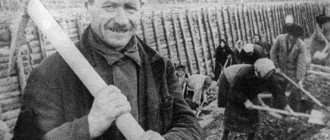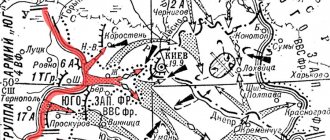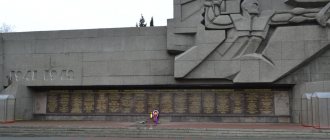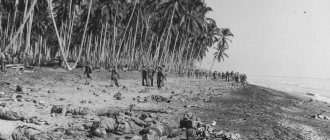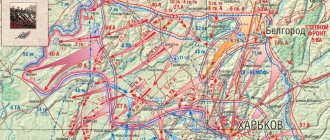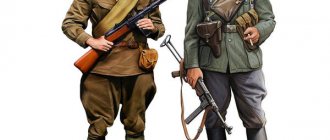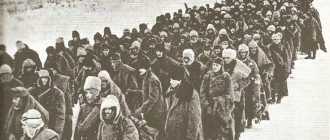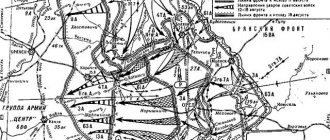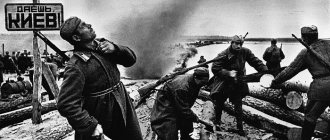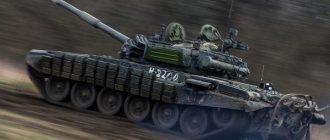Hitler considered the capture of Leningrad, the “northern capital of the Soviet Union,” as the most important goal of the general offensive of German troops in the USSR. Setting the goal of capturing the city to the commander of Army Group North, Field Marshal W. von Leeb, the German command emphasized that it considered this an “urgent task.” Having concentrated the German Army Group North and two Finnish armies - the South-Eastern and the Karelian - in the direction of the attack, A. Hitler argued that “in three weeks we will be in St. Petersburg.”
FROM HITLER’S DIRECTIVE “THE FUTURE OF ST. PETERSBURG” OF SEPTEMBER 29, 1941
- The Fuhrer decided to wipe the city of St. Petersburg from the face of the earth. After the defeat of Soviet Russia, the existence of this huge city will not make any sense. Finland also informed us that it is not interested in the continued existence of the city near its new borders.
- The previous demands of the Navy to preserve the shipyards, harbor and naval structures are known, but their implementation is impossible due to the main decision on the issue of St. Petersburg.
- It is proposed to tightly blockade the city and raze it to the ground using artillery of all calibers and continuous bombing from the air. If, as a result of the situation created in the city, applications for the surrender of the city follow, they must be rejected...
The German-Finnish troops in the Leningrad direction were opposed by the Northern Front under the command of Lieutenant General M. Popov and the Northwestern Front under the command of Major General P. Sobennikov. The battle for Leningrad itself began on July 10, 1941, when the advanced units of the 4th German Tank Group launched a strike from the Pskov area in the direction of the city of Luga. This created a real threat to the capture of the city from the south. To prevent the further advance of enemy tank columns, the Headquarters of the Main Command ordered the commander of the Northern Front to organize the defense of the city in this direction and take up defense at the border of the cities of Narva-Luga-Shimsk.
Red Army recruits are sent to defend the approaches to Leningrad. Summer 1941
Temporary front stabilization
Developing the offensive, units of Army Group North reached the Luga River line by the end of July, at the cost of heavy losses. Here they encountered fierce resistance from parts of the Luga operational group and were forced to stop the offensive and go on the defensive. In the north, troops of the Northern Fleet, with the support of ships of the Ladoga Military Flotilla, fought stubborn defensive battles with units of the Karelian and South-Eastern Finnish armies during July and August. Only by the end of September did Soviet troops manage to stabilize the front in this sector at the turn of the Svir River.
Finland enters the war
On June 25, 1941, Finland entered the war against the USSR. Having concluded a shameful peace for itself as a result of the “Northern War” and having become disillusioned with the alliance with Great Britain, the Finnish government began moving towards rapprochement with Germany in the summer of 1940. On May 25, 1941, German-Finnish negotiations at the level of chiefs of staff took place at Hitler's headquarters in Salzburg. Based on the results of the negotiations, the German generals concluded that Finland is fully ready for military cooperation. However, the issue of Finland's entry into the war with the USSR remained controversial. However, on June 25, 1941, the Soviet Air Force bombed Finnish cities and airfields with up to 500 aircraft. On the evening of the same day, at a meeting of the Finnish Parliament, it was announced that the country was entering a war, which would begin in the same way as the previous one (Soviet-Finnish 1939-1940) - with an attack by the Soviet Union.
Finnish soldiers cross the border with the Soviet Union. Summer 1941
The advancing units of the Finnish army on the Karelian Isthmus met fierce resistance from the Red Army defending the approaches to Leningrad. According to one version, this is what prevented the Finnish army from launching an attack on Leningrad. According to another, the Finnish government deliberately refused to participate in the capture of the “northern capital” of the Soviet Union, which was officially announced during negotiations with General A. Jodl in Mikkeli on September 4, 1941. In October-November 1941, K. Mannerheim also refused to participate in the Tikhvin operation, believing that Finland entered the war with the USSR only in order to regain its territories. An attempt was made to inform the British government about this, but it was too late - the British managed to declare war on Finland.
Battles from September 17-23, 1941
On September 17, 1941, the Military Council of the Leningrad Front issued a decree with the demand: “One step back from the occupied line!” The Soviet Army was able to contain the enemy forces. Defensive battles near Krasnogvardeysk and Kolpino, which began on September 10. By order of the Supreme Command Headquarters, the assault of the Soviet army from the outskirts of Volkhov in the direction of the settlements of Mga and Sinyavino helped pin down a significant enemy force.
At the same time, from the right bank of the Neva towards Sinyavino and Mgi, the Neva operational group began to advance, which by 26.09. crossed the waters of the Neva and captured a small fortification near the village of Dubrovka in the Moscow region (the so-called Nevsky Piglet).
By mid-September, the German army reached the Gulf of Finland near Strelna and blocked the Soviet Army, which was in a western direction, which, with the participation of the Baltic Fleet, was able to preserve the Primorsky (Oranienbaum) fortification. Any attempt by enemy forces to break through the Neva and meet the Finnish army, as well as to move further along the Moscow-Leningrad road and capture the city, ended in failure.
The massive strikes of the German aviation fleet against the ships of the Baltic Flotilla and Kronstadt, carried out on September 21-23, also failed to achieve their goals. By the end of September, the front line in the vicinity of Leningrad had stabilized. The operation to occupy the city, developed by the German command, was immediately defeated, which is why the enemy’s intentions to send the main forces of the army group “North” to storm Moscow were thwarted.
Fall of Novgorod
On August 8, 1941, the Germans launched a new offensive. With a swift strike from tank units, they broke through the defenses of the Soviet troops organized on the Luga River. Despite fierce resistance from Soviet soldiers, on August 16, German tanks entered the city of Kingisepp and cut the railway connecting Tallinn and Leningrad. Developing the offensive, by August 21 they reached the city of Krasnogvardeysk. Finding themselves 40-50 km from Leningrad, the German troops were stopped at the positions of the Krasnogvardeisky fortified area. To the west, in the Oranienbaum direction, the German offensive was stopped in the area of the city of Koporye. In the Luga direction, the soldiers of the Luga operational group stopped the Germans at the line of their defense. However, to the east of their positions, troops of the 16th German Army struck in the direction of Novgorod, crushed the defenses of the Soviet troops and captured the western part of the city on August 16. On August 20, Novgorod fell, and units of the Northern Front continued their retreat to Leningrad.
Creation of the Leningrad Front
The situation on the fronts that created at the end of August 1941 posed a real threat to the encirclement of Leningrad. Under these conditions, on August 23, the Headquarters, based on the troops of the Northern Front, created the Leningrad Front, which was entrusted with the direct defense of the city. The reorganization of troops and personnel changes did not greatly affect the defense capability of the Soviet troops. The small number of reserves allocated by the Headquarters did not allow the troops of the Leningrad Front to stop the German offensive in the south and the Finnish offensive in the north. On August 25, German units captured the city of Lyuban and, striking in an eastern direction (at Gorodishche), on August 30 they cut both railways connecting Leningrad with the center of the country. To the west, German troops reached the Mga station and, continuing their movement, captured the city of Shlisselburg on September 8. Thus, the German command managed to complete the encirclement of the city by land. From that moment on, supplies to the residents of the besieged city and the troops of the Leningrad Front were carried out only through Lake Ladoga and by air.
Construction of a defensive ring
Already at the end of June 1941, construction of various types of defensive structures began on the approaches to Leningrad. A powerful defense system, consisting of several belts, was created directly around the city. The Krasnogvardeisky and Slutsk-Kolpinsky fortified areas were built in the southern direction, and the Karelian fortified area was built to protect the city from the north. A belt of defensive structures was also erected along the Peterhof-Pulkovo line. Along with the external defense, the internal defense of Leningrad was also created.
Construction of defensive fortifications. July 1941
Strengths on both sides
By July 10, 1941, in the vicinity of Leningrad in the southwest and northwest there were located:
- 38 enemy formations (infantrymen - 32, tankers - 3, motorcyclists - 3);
- 1 cavalry brigade;
- 2 infantry brigades.
The total number of enemy forces at this moment was:
- soldiers - 810,000 people;
- tanks and assault weapons – 440;
- artillery weapons and mortars - approximately 5,300;
- airplanes – approximately 1200.
The Northern Front, led by Lieutenant General Popov, opposed the German and Finnish armies, which included:
- 7th and 23rd combined arms armies (8 formations);
- The armies of the Northwestern Front under the command of Major General Sobennikov. They included the 8th, 11th and 27th combined arms armies (31 divisions and 2 brigades).
By the time the Battle of Leningrad began, the Northern and Northwestern Front, as well as the Baltic Fleet under the leadership of Vice Admiral Tributs, consisted of:
- soldiers - approximately 540,000;
- tanks - approximately 700;
- artillery weapons and mortars - approximately 5000;
- combat aircraft - 235;
- warships – 19.
To improve the strategic leadership of the army, the State Defense Committee of the USSR formed the Main Command of the North-Western Front Line on July 10, 1941 (USSR Marshal Voroshilov was placed at its head). The troops of the Northern, Northwestern Fronts, Northern and Baltic Flotillas came under his command.
On the distant and close approach to Leningrad, soldiers, in collaboration with the population, were engaged in the construction of fortifications (with a total length of approximately 900 km). In addition, a people's militia was formed in the amount of 10 divisions (approximately 160,000 people) and several dozen partisan detachments. Children, some industrial installations and objects of cultural value were evacuated from the city. The remnants of industry were rebuilt, and military equipment, weapons and ammunition began to be produced here.
Temporary suspension of the offensive
On September 25, 1941, the commander of Army Group North, Field Marshal W. von Leeb, reported to A. Hitler that he could not continue the offensive with the forces he had. The reserves, which were now more needed in the Moscow direction, were not allocated to him. Despite the fact that German troops suspended their offensive, the situation in besieged Leningrad was extremely difficult.
Soviet fortifications on the border captured by Finnish troops. 1941
Leningrad siege survivors
Together with residents of suburban areas, 2 million 887 thousand people were trapped in the blockade ring, of which about 400 thousand were children. For them, the difficult days of the almost 900-day blockade began, accompanied by hunger and incessant shelling and bombing. It is estimated that during the battle for the city, about 150 thousand shells were fired through its neighborhoods and more than 100 thousand bombs were dropped. For every square kilometer of Leningrad there were on average 16 high-explosive bombs, over 320 incendiary bombs and 480 artillery shells. During the days of the blockade, about 16.5 thousand city residents died under shelling, and up to 35 thousand were injured. But a more terrible weapon against the inhabitants of the unconquered city was hunger - it claimed more than 1 million lives.
In the winter of 1941-1942. There was no food left in the city, the shops were not open, and only bread was issued using ration cards. Soldiers on the front line received 500 g of bread per day, workers - 250 g, employees and dependents (children, old people, disabled people) - 125 g. One slice - 125 g, which we cut for ourselves for a plate of soup - this was the daily food of the siege survivors ! Only half of the siege bread consisted of flour, the rest was cake, bran, bark, and sawdust.
People died of hunger in the streets, froze to death in the terrible frosts of the blockade winter, and died from bombings. And yet, Leningraders worked for days on end collecting equipment and ammunition for the front in factories, caring for the wounded in hospitals, defusing incendiary bombs. Theaters and concert halls operated to raise the morale of the siege survivors.
The headquarters maintained constant contact with the Leningrad Front; commanders regularly flew there, assessing the situation on the spot and adjusting military plans. The country supported Leningrad.
On the street of besieged Leningrad
Monument to the blockade tram. Installed on the site of the defense line, to which the tram approached in 1941.
Products by cards
On July 18, 1941, in accordance with the decision of the Soviet government, a card system was introduced in Leningrad, which made it possible to streamline the supply of the population. In July and August 1941, workers received ration cards for 800 g of bread per day, employees - 800 g, dependents and children - 400 g. Approximately in accordance with the same principle, monthly norms for the distribution of other types of food were determined: cereals, meat and meat products, fats and confectionery products. However, already from October 1, 1941, workers and engineers began to be given 400 g of bread, and other categories of the population - 200 g per day.
Bread card of a blockade survivor for December 1941.
The legendary "Road of Life"
The “Road of Life” was the only transport route across Lake Ladoga to besieged Leningrad. During periods of navigation, it passed on water, and in winter - on ice. Thanks to this “route”, it was possible to organize the supply of ammunition, weapons, food, medicine, fuel to the besieged city and to evacuate the sick, wounded and disabled from Leningrad. In the period from November 1941 to April 1942 alone, more than 500 thousand people were taken from the city to the “Mainland”. The work of the route did not stop for a single day, despite bombings, shelling and bad weather. This made it possible to somewhat improve the supply of food to people and, starting from December 25, 1941, to increase the bread ration to 200-350. And from January 24, 1942, Leningraders began to receive 400 g of bread per work card, 300 g for employees and 250 g - for child and dependent cards.
The GAZ-AA truck, better known as the “lorry” (carrying capacity 1.5 tons), became the main vehicle for transportation along the “Road of Life”
Attempt to unblock the city
In 1942, all attempts to break the blockade in the famous battles on the Neva patch were unsuccessful. However, the Germans’ desire to finish off the city with the help of new Tiger tanks also turned out to be ineffective. At the end of the summer of 1942, Hitler’s vehicles were “put into use” not during the assault on the city, but when repelling the unexpected offensive of the shock army of Soviet General Andrei Vlasov. And although this army was surrounded and destroyed, and the general himself was captured and subsequently went over to the enemy’s side, the Nazis no longer had enough strength to strike Leningrad. And in January 1943, our troops were able to cut through a corridor south of Shlisselburg - and the blockade was broken. As a trophy, the Soviet command received a secret German Tiger tank in good condition. Therefore, by the beginning of the fighting on the Kursk Bulge, it was already clear how to fight him.
Fire from anti-aircraft guns deployed in the area of St. Isaac's Cathedral
Fire assistance from the Baltic Fleet
Powerful fire support from naval (both naval and coastal) artillery provided great help to the city’s defenders. In total, the Baltic Fleet used 345 gun barrels against the enemy, with calibers ranging from 100 to 406 mm, and fired about 25 thousand shells at his troops. The role of the artillery of the Baltic Fleet was highly appreciated even by German officers. For example, in German memoirs one can find the opinion that, if not for the naval artillery, Leningrad would certainly have been taken.
406-mm naval gun B-37, installed on the approaches to Leningrad
Siege of 1942
But the situation in Leningrad remained tense. Resources were limited, food and fuel supplies were running out. The townspeople began to starve. In addition, the German command made attempts to crush the resistance of the city's defense by carrying out air bombing and shelling with heavy artillery guns.
To counter long-range artillery guns, a special front-line counter-battery group is being created on the Leningrad Front. In the summer of 1942, planning and implementation of artillery (and later artillery-aviation) strikes against the enemy shelling Leningrad began.
By June, shelling in the city became significantly less, and in October the number decreased by 3-4 times. In the vicinity of the city, the emergence of a mass sniper movement began. By decree of the Presidium of the Armed Forces of the Soviet Union, issued on February 6, 1942, the ten best snipers operating on the Leningrad Front received the title of Hero of the USSR, and 130 people received orders and medals.
Guerrilla activity was also active, which helped to distract numerous opponents from the front. Any attempt to lift the blockade of Leningrad in 1942 (assaults in the Lyuban direction from January to April, as well as in the Sinyavsk direction from August to October) was unsuccessful. The forces and means were insufficient and there were shortcomings in drawing up the operation plan. But this active activity of the Soviet troops helped to disrupt the preparations for a new assault on the city.
Counterattack of the Soviet Army during the Battle of Stalingrad 1942-1943. forced the leadership of the German troops to transfer part of the army from the outskirts of Leningrad, which made it possible to lift the blockade from the city.
Liberation of Leningrad
In January 1944, troops of the Leningrad Front carried out Operation January Thunder. Converging attacks from Oranienbaum to Peterhof and from Leningrad to Ropsha encircled one of the Sever GA groups. The front line united on January 19, and the blockade was lifted on January 27.
At the same time, troops of the Volkhov Front liberated Novgorod. By the combined efforts of the Leningrad and Volkhov fronts, by March 1944, the Leningrad and Novgorod regions were almost completely liberated.
Share link
USSR actions
21.08. The State Defense Committee of the USSR sent a commission to Leningrad consisting of:
- Voronova;
- Zhigareva;
- Kosygina;
- Kuznetsov;
- Malenkova;
- Molotov.
Based on the results of the inspection, a decision was made to liquidate the Main Command in the North-Western direction. Headquarters of the Supreme Commander-in-Chief 23.08. The Northern Front was divided into the Karelian Front under the command of Lieutenant General Frolov and the Leningrad Front under the leadership of Popov (05.09 he was replaced by Voroshilov, and 12.09 by General of the Soviet Army Zhukov).
GKO USSR 27.08. The Main Command in the North-Western direction was disbanded, and the troops of the Karelian, Leningrad and North-Western (from August 23, under the leadership of Lieutenant General Kurochkin) fronts were transferred to the direct subordination of the Headquarters of the Supreme Commander-in-Chief.
